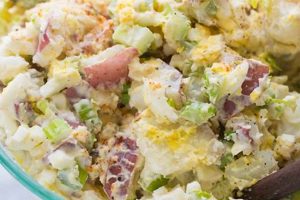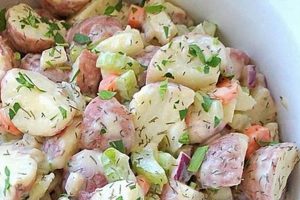Potato salads made with red-skinned potatoes and dressings other than mayonnaise offer a lighter, often tangier, alternative to traditional versions. These recipes typically involve boiling or steaming the potatoes until tender, then tossing them with a vinaigrette, herbs, and other vegetables. A simple example includes cooked red potatoes dressed with olive oil, red wine vinegar, Dijon mustard, chopped celery, and fresh parsley.
This style of potato salad offers several advantages. Red potatoes hold their shape well after cooking, making them ideal for salads. Avoiding mayonnaise reduces the overall fat content and allows the flavors of the other ingredients to shine through. Furthermore, vinaigrette-based dressings offer greater flexibility for customization, accommodating various flavor profiles from tangy and herbaceous to spicy and sweet. Historically, mayonnaise-based potato salad became popular in the early 20th century with the rise of commercially produced mayonnaise. Recipes featuring vinegar-based dressings, however, predate this period and reflect earlier culinary traditions.
The following sections will explore various dressing options, ingredient combinations, and tips for preparing delicious and visually appealing potato salads without mayonnaise, catering to diverse tastes and dietary needs.
Tips for Crafting Exceptional Mayonnaise-Free Red Potato Salad
Achieving a flavorful and well-balanced red potato salad without mayonnaise requires attention to detail and a thoughtful approach to ingredient selection and preparation. The following tips offer guidance for creating a dish that is both delicious and visually appealing.
Tip 1: Select the Right Potatoes: Small to medium-sized red potatoes are ideal, as they hold their shape well during cooking. Avoid overly large potatoes, which may become crumbly.
Tip 2: Cook Potatoes Evenly: Ensure potatoes are cooked until fork-tender but not mushy. Overcooked potatoes will result in a less appealing texture. Uniformly sized potatoes will cook evenly.
Tip 3: Dress Potatoes While Warm: Warm potatoes absorb dressings more readily, resulting in more flavorful and evenly coated pieces.
Tip 4: Explore Flavorful Vinaigrettes: Experiment with different vinegars, oils, and herbs to create unique flavor profiles. Consider using red wine vinegar, apple cider vinegar, or white wine vinegar as a base.
Tip 5: Incorporate Fresh Herbs: Fresh herbs such as parsley, dill, chives, or oregano add brightness and complexity to the salad.
Tip 6: Add Textural Variety: Incorporate ingredients like chopped celery, red onion, bell peppers, or corn for added texture and visual appeal.
Tip 7: Season Thoughtfully: Salt and freshly ground black pepper are essential, but other seasonings, like Dijon mustard, garlic powder, or smoked paprika, can enhance the flavor profile.
Tip 8: Chill Thoroughly: Allow the salad to chill for at least an hour before serving to allow the flavors to meld. This also improves the texture.
By following these tips, one can create a red potato salad that is not only a healthier alternative to traditional mayonnaise-based versions but also a vibrant and satisfying dish.
By understanding the nuances of potato selection, cooking methods, and flavor combinations, culinary enthusiasts can elevate this simple dish to new heights.
1. Red Potatoes
Red potatoes are central to recipes for potato salad that omit mayonnaise. Their unique characteristics make them a suitable choice for this style of preparation, influencing both the texture and flavor of the final dish.
- Waxy Texture and Moisture Content:
Red potatoes possess a waxy texture, characterized by a lower starch content compared to russet potatoes. This quality allows them to hold their shape well during cooking, preventing them from becoming overly soft or mushy when mixed with other ingredients. Their inherent moisture contributes to a creamy mouthfeel without reliance on mayonnaise.
- Thin Skin and Earthy Flavor:
The thin, edible skin of red potatoes contributes a subtle earthy flavor that complements the other components of the salad, particularly the vinaigrette and herbs. Leaving the skin on also adds visual appeal and provides additional nutrients and fiber.
- Versatility in Cooking Methods:
Red potatoes can be boiled, steamed, or roasted, providing flexibility in preparation methods for the salad. Boiling or steaming results in a softer texture, suitable for classic potato salad, while roasting imparts a slightly caramelized flavor and firmer texture, adding complexity to the dish.
- Nutritional Value:
Red potatoes offer a good source of potassium, vitamin C, and dietary fiber. These nutritional benefits, combined with the avoidance of mayonnaise, contribute to a healthier potato salad option.
These combined attributes the waxy texture, thin skin, versatility in cooking, and nutritional value position red potatoes as an excellent choice for mayonnaise-free potato salads, offering both culinary and health advantages. Their ability to retain their shape and absorb flavors while providing a pleasing texture allows for a robust and flavorful salad experience without the need for a creamy, high-fat dressing.
2. Vinaigrette Dressings
Vinaigrette dressings serve as the cornerstone of red potato salad recipes that omit mayonnaise. They offer a lighter, brighter alternative, enhancing the natural flavors of the potatoes and other ingredients while contributing a refreshing tang. Understanding the components and versatility of vinaigrettes is crucial for creating a successful mayonnaise-free potato salad.
- Acidity:
The acidic component of a vinaigrette provides the characteristic tang and helps to balance the other flavors in the salad. Common choices include red wine vinegar, apple cider vinegar, white wine vinegar, and lemon juice. The specific acid chosen influences the overall flavor profile; for example, red wine vinegar adds a robust, slightly fruity note, while lemon juice offers a brighter, more citrusy flavor. The level of acidity can be adjusted to suit individual preferences.
- Oil:
Oil contributes richness and mouthfeel to the vinaigrette. Extra virgin olive oil is a popular choice due to its flavor and health benefits, but other oils, such as avocado oil or grapeseed oil, can also be used. The ratio of oil to acid typically ranges from 2:1 to 3:1, with a higher oil content resulting in a richer, less tangy dressing.
- Emulsification and Seasoning:
While not a true emulsion like mayonnaise, vinaigrettes benefit from being whisked vigorously to create a temporary blend of the oil and acid. This helps to distribute the flavors evenly throughout the salad. Seasonings, such as Dijon mustard, salt, pepper, garlic powder, and herbs, further enhance the complexity of the vinaigrette. Mustard also acts as an emulsifier, helping to bind the oil and vinegar together.
- Flavor Combinations and Customization:
The versatility of vinaigrettes allows for a wide range of flavor combinations. Herbs, such as dill, parsley, chives, or oregano, can be added to complement the other ingredients. Other additions, such as minced garlic, shallots, or a touch of honey or maple syrup, can further customize the flavor profile. The choice of ingredients should complement the overall flavor profile desired for the potato salad.
The careful selection and combination of these vinaigrette components allows for a nuanced and flavorful dressing that enhances the overall enjoyment of red potato salad without the need for mayonnaise. The balance of acidity, oil, and seasonings creates a vibrant and refreshing counterpoint to the earthy potatoes and other vegetables, resulting in a lighter, more flavorful dish.
3. Fresh Herbs
Fresh herbs play a crucial role in elevating red potato salad recipes without mayonnaise, contributing brightness, complexity, and aromatic depth that complements the earthy potatoes and tangy vinaigrette. Their presence elevates the salad from simple to sophisticated, offering a nuanced flavor profile that engages the palate.
- Aromatic Enhancement:
Fresh herbs impart distinctive aromas that enhance the overall sensory experience of the salad. The volatile oils released by herbs like dill, parsley, chives, and tarragon create a fragrant counterpoint to the other ingredients, stimulating appetite and adding a layer of complexity beyond the basic flavors.
- Flavor Dimension and Balance:
Herbs contribute a wide range of flavor notes, from the bright, grassy notes of chives to the subtly anise-like flavor of tarragon. These flavors interact with the potatoes and vinaigrette, creating a balanced and nuanced taste profile. The herbaceous notes cut through the richness of the potatoes and complement the acidity of the vinaigrette, preventing the salad from tasting bland or one-dimensional.
- Visual Appeal and Texture:
In addition to flavor and aroma, fresh herbs enhance the visual appeal of the salad. The vibrant green hues of parsley, dill, and chives provide a welcome contrast to the red potatoes and other ingredients. The delicate texture of the herbs also adds a subtle textural element, further enhancing the overall sensory experience.
- Nutritional Benefits:
Many fresh herbs offer nutritional benefits, contributing vitamins, minerals, and antioxidants to the salad. Parsley, for example, is a good source of vitamins K and C, while dill provides vitamin A and folate. Incorporating fresh herbs not only enhances the flavor and appearance of the salad but also adds nutritional value.
The strategic use of fresh herbs in red potato salad without mayonnaise demonstrates a thoughtful approach to flavor building and culinary artistry. Their inclusion elevates the dish from a simple side to a more complex and satisfying culinary experience, showcasing the potential of fresh, natural ingredients to create a vibrant and flavorful salad.
4. Complementary Vegetables
Complementary vegetables play a vital role in enhancing the flavor, texture, and nutritional value of red potato salad without mayonnaise. Their inclusion addresses the potential monotony of a potato-centric dish, adding layers of complexity and visual appeal. The selection of complementary vegetables should consider their individual characteristics and how they interact with the potatoes and vinaigrette.
Cruciferous vegetables, such as chopped broccoli or cauliflower florets, offer a contrasting texture and slightly bitter flavor that balances the creamy potatoes and tangy vinaigrette. Alliums, like finely diced red onion or thinly sliced shallots, provide a pungent bite and contribute to the overall complexity of the salad. Peppers, whether bell peppers or a touch of finely diced jalapeo, introduce sweetness or heat, respectively, further broadening the flavor profile. Celery adds a crisp, refreshing element, while chopped cucumbers provide a cooling contrast. The quantity and variety of these additions can be adjusted based on individual preferences and the desired overall flavor profile. For example, a Mediterranean-inspired salad might include chopped cucumbers, Kalamata olives, and crumbled feta cheese, while a more traditional approach might feature celery, red onion, and hard-boiled eggs.
The considered inclusion of complementary vegetables transforms red potato salad without mayonnaise into a more complete and satisfying dish. It addresses potential textural and flavor imbalances, providing a more nuanced and enjoyable culinary experience. Understanding the role and impact of these vegetables allows for a more deliberate approach to recipe development, resulting in a salad that is not only flavorful and visually appealing but also nutritionally balanced.
5. Proper Cooking Techniques
Proper cooking techniques are essential for achieving optimal texture and flavor in red potato salad without mayonnaise. Undercooked potatoes result in an unpleasant, firm texture and raw flavor, detracting from the overall enjoyment of the salad. Overcooked potatoes, conversely, become mushy and disintegrate when mixed with other ingredients, compromising both the texture and visual appeal. The absence of mayonnaise, which typically masks textural imperfections, amplifies the importance of properly cooked potatoes. A successful outcome relies on achieving a tender yet firm consistency, allowing the potatoes to hold their shape while absorbing the flavors of the vinaigrette and other components.
Boiling or steaming are common methods for cooking potatoes destined for salad. Uniformly sized potatoes ensure even cooking. A gentle simmer, rather than a rolling boil, prevents the potatoes from breaking apart. Testing for doneness with a fork or knife tip provides a reliable indicator of readinessthe implement should pierce the potato easily but encounter slight resistance. Immediately draining the potatoes after cooking prevents further softening from residual heat. Cooling the potatoes slightly before adding the vinaigrette and other ingredients allows for better absorption of flavors and prevents the dressing from becoming overly thin.
Mastery of proper cooking techniques significantly contributes to the success of red potato salad recipes without mayonnaise. The desired textural outcome, a tender yet firm potato, relies on precise control of cooking time and temperature. This understanding allows for consistent preparation of high-quality potato salad that showcases the flavors of the ingredients without reliance on mayonnaise to mask imperfections. The interplay between cooking method, potato variety, and desired outcome highlights the crucial role of culinary expertise in creating a seemingly simple yet nuanced dish.
6. Flavor Balancing
Flavor balancing is paramount in red potato salad recipes without mayonnaise. The absence of mayonnaise, which often contributes a significant amount of richness and creaminess, necessitates a more nuanced approach to flavor development. A successful recipe hinges on a harmonious interplay of contrasting yet complementary tastes: the inherent earthiness of red potatoes, the tang of the vinaigrette, the brightness of fresh herbs, and the textural and flavor contributions of other vegetables. Without careful consideration of these elements, the salad can easily become bland, overly acidic, or unbalanced.
The principle of flavor balancing in this context involves a strategic combination of salty, sweet, sour, and bitter elements. The saltiness typically comes from the dressing and any additional seasonings. A touch of sweetness can be introduced through ingredients like finely diced red onion or a small amount of honey or maple syrup in the vinaigrette. The sourness is primarily derived from the vinegar in the dressing, and bitter notes can be introduced through certain vegetables, such as radishes or arugula. A classic example of flavor balancing in this type of salad involves a Dijon vinaigrette (salty, slightly sour, and subtly sweet) combined with red potatoes, chopped celery (slightly bitter and vegetal), and fresh parsley (bright and herbaceous). The interplay of these flavors creates a multi-dimensional taste experience, preventing any single flavor from dominating.
Understanding flavor balancing empowers one to create dynamic and satisfying red potato salads without relying on mayonnaise. This knowledge allows for adjustments to ingredients and seasonings to achieve the desired flavor profile. Successfully balancing these elements results in a vibrant and refreshing salad that highlights the quality of the individual components, demonstrating a deeper understanding of culinary principles and flavor interactions.
Frequently Asked Questions
This section addresses common inquiries regarding red potato salad recipes without mayonnaise, offering clarity and practical guidance for achieving optimal results.
Question 1: Can other potato varieties be used in these recipes?
While red potatoes are preferred for their waxy texture and ability to hold their shape, other varieties like Yukon Gold or fingerling potatoes can be substituted. However, adjustments to cooking times may be necessary, and the final texture may differ.
Question 2: How long can the potato salad be stored?
Stored in an airtight container in the refrigerator, the salad can typically last for 3-5 days. The quality may degrade over time as the vegetables release moisture.
Question 3: What are some suitable vegan alternatives to traditional ingredients?
Vegan alternatives can easily be incorporated. Instead of using honey or maple syrup in the dressing, agave nectar or maple syrup can be used to add sweetness. Ensure other added ingredients, like relish, are also vegan-friendly.
Question 4: How can one prevent the potatoes from becoming discolored after cooking?
Adding a small amount of lemon juice or vinegar to the cooking water helps prevent discoloration and maintains the vibrant color of the potatoes.
Question 5: What can be done if the vinaigrette is too acidic?
A touch of sweetness, such as a small amount of honey or maple syrup, can balance excessive acidity. Alternatively, a small amount of additional oil can be whisked into the dressing.
Question 6: Can the potatoes be roasted instead of boiled or steamed?
Roasting the potatoes adds a deeper, slightly caramelized flavor and a firmer texture. Ensure the potatoes are adequately seasoned before roasting and are allowed to cool slightly before being combined with the other ingredients.
Addressing these common questions provides a comprehensive understanding of preparing red potato salad without mayonnaise. Emphasis on proper cooking techniques, flavor balancing, and ingredient selection ensures a successful outcome.
This concludes the FAQ section. The following section provides example recipes.
Conclusion
Exploration of red potato salad recipes without mayonnaise reveals a versatile and flavorful alternative to traditional mayonnaise-based versions. Emphasis on proper cooking techniques, specifically achieving a tender yet firm potato texture, ensures a desirable foundation. Careful consideration of vinaigrette composition, incorporating balanced acidity, oil, and seasonings, creates a vibrant dressing that complements the earthy potatoes. Strategic inclusion of fresh herbs and other complementary vegetables contributes further complexity, both texturally and in flavor. Successful execution relies on a holistic understanding of ingredient interactions and flavor balancing principles.
Red potato salad recipes without mayonnaise represent a departure from conventional approaches, offering a lighter, often more flavorful experience. This approach invites culinary exploration and customization, encouraging adaptation based on individual preferences and dietary needs. The potential for creativity within this framework underscores the enduring appeal of potato salad as a culinary canvas.






